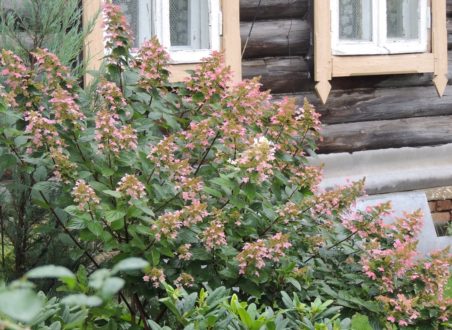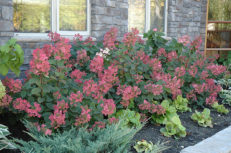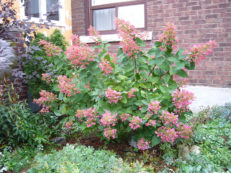Bright, unusually beautiful hydrangea bushes are a wonderful decoration of any garden. Pink Diamond is one of the most popular representatives of the species, possessing large, long inflorescences.
Material Content:
Grade description
Hydrangea Pink Diamond grows up to 2-3 meters in height and about 3 meters in width. This variety is very much appreciated in different countries of the world for its long flowering, vertical growth and strong shoots.
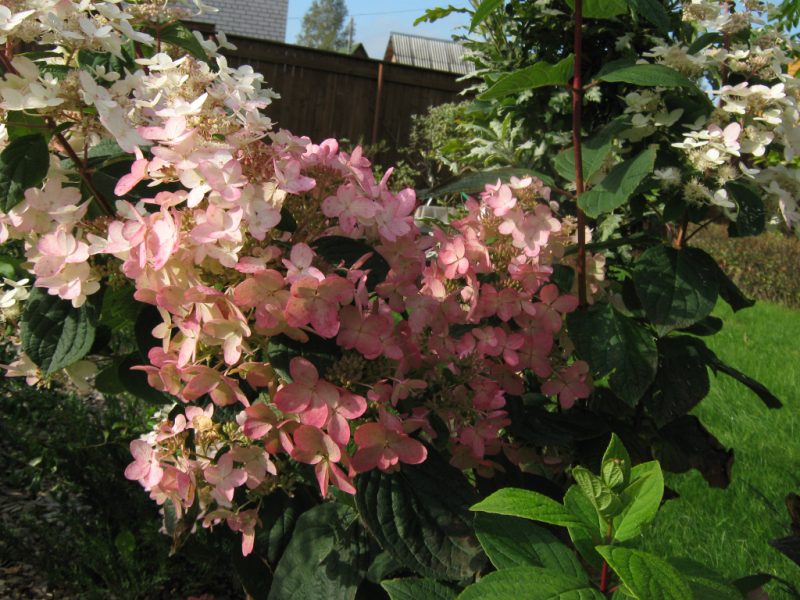
Inflorescences of panicled hydrangea grow from 15 to 30 cm. Despite all their massiveness, they grow vertically upward, not drooping to the side and not afraid of the winds. The color at the beginning of flowering is creamy white, but over time it changes, transforming into a dark pink and even red hue. Flowering of this variety lasts from mid-summer to mid-autumn.
Over a year, the plant grows by about 30 centimeters. With each new season, it is gaining strength and growing stronger, releasing new shoots. Hydrangea leaves are dull green, which gives the bush a contrast, against the background of bright shades of inflorescences.
Seed selection and hydrangea planting in open ground
The culture is most convenient to plant in two ways - seeds and cuttings. Each has its own subtleties. Consider them.
Seed planting
Planting hydrangeas from seeds requires a competent approach. To begin with, you should know how they look so as not to get a fake at the output.

When buying hydrangea seeds, pay attention to the producer. It is better if they are delivered from China or Japan. In these countries, hydrangea grows in vivo.
Hydrangea seeds should be:
- Clean, without spots and damage;
- No traces of freezing, lethargy or disease.
The color of the seeds is dark brown, they are oblong in shape and very small.
Sowing is best done in the fall. The substrate should consist of sheet, sod land, as well as sand in the proportions of 4: 2: 1. Seeds are sown in specially prepared boxes. After sowing, they are covered with the same substrate from above.
The temperature must be maintained at a level of 15-20 degrees, and the earth regularly moistened. After a month and a half, the first shoots appear that are thinned out. After the appearance of 2-3 leaves on the seedlings, they are transplanted into separate containers with a diameter of at least 7 cm.

In the summer, the pots can be taken out into the fresh air, but not placed in the sun. The seedlings must not be allowed to stand in a draft or in the rain. In winter, they continue to grow in a cool, dark room.
In open ground, it can be planted only after three years. All this time, flowering should not be allowed, so the peduncles break off even before their active growth.
Planting by cuttings
Planting hydrangea in the Cherenkov way also has its own nuances. It is possible to plant cuttings both in the early spring, and in the summer, and also autumn season. Sprouts are planted at a distance of at least one meter from each other.

The diameter of the pit for the handle is dug several times more than the roots. A fertile mixture is added to the bottom, which mixes with the soil. Hydrangea loves acidic soils, so it’s better to buy ready-mixed soil in the store. The roots should be completely covered with soil. After planting, the soil should be slightly tamped and watered abundantly. Mandatory mulching is also required.
Hydrangea loves shady, "openwork" places, with enough moisture and acidic soil.
Pink Hydrangea Panicled Hydrangea Care
Hydrangea Pink Diamond is an incredibly beautiful plant. But for it to please for many years, care is needed for it. For proper growth, the plant needs to be fertilized. This is done in the fall, during the process of bud formation, and in the spring.

When the bush forms buds, top dressing is essential. Fertilizers will contribute to a quick set of growth in the spring. And during the formation of peduncles, top dressing will help form a large number of buds. In the autumn season, hydrangea thanks to them, will be able to gain strength for wintering and lay the foundation for healthy growth in the spring.
But caring for hydrangea, it is necessary not only to fertilize it, but also to trim it in certain seasons. In autumn, all dried inflorescences are removed, and in the spring, broken or damaged sprouts are cut.
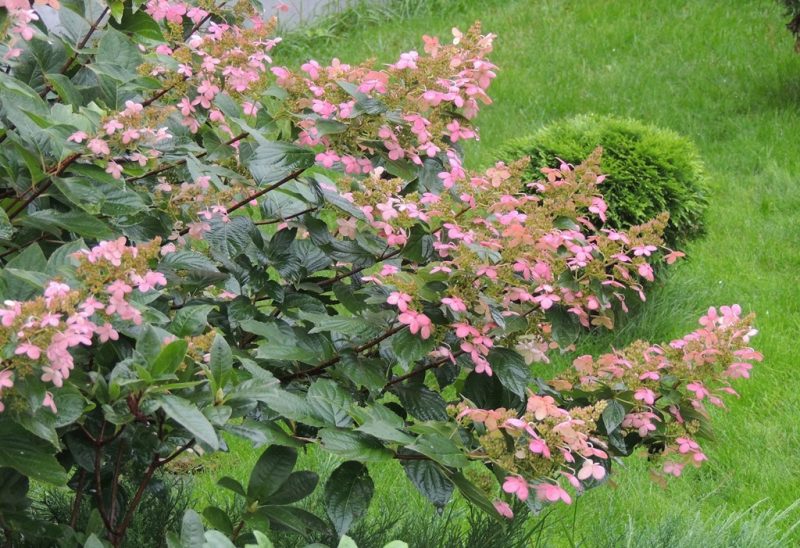
Pruning is also important for bush formation. All old, dry stems are best removed. Those that grow for about a year should be reviewed and truncated to 3-5 kidneys. All this will help the plant bloom profusely in the summer.
Hydrangea is rarely affected by pests and is susceptible to disease. With proper care, it grows in a strong and healthy bush for many years.
It is interesting:outdoor dahlias
Preparing the plant for wintering
Panicled hydrangea, with proper preparation, tolerates winter well. The main task is to prevent last year's shoots from freezing, from which flowering will occur in the next season.

Preparing the plant for winter, the branches bend to the ground and sprinkle with foliage. Especially this method is good for the conservation of young plants. In the central regions of the country, an adult plant tolerates winter well and without shelter.
Methods of propagation of hydrangea Pink Diamond
Hydrangea propagates in different ways: seeds, cuttings, layering. Let's consider in more detail.
Seeds
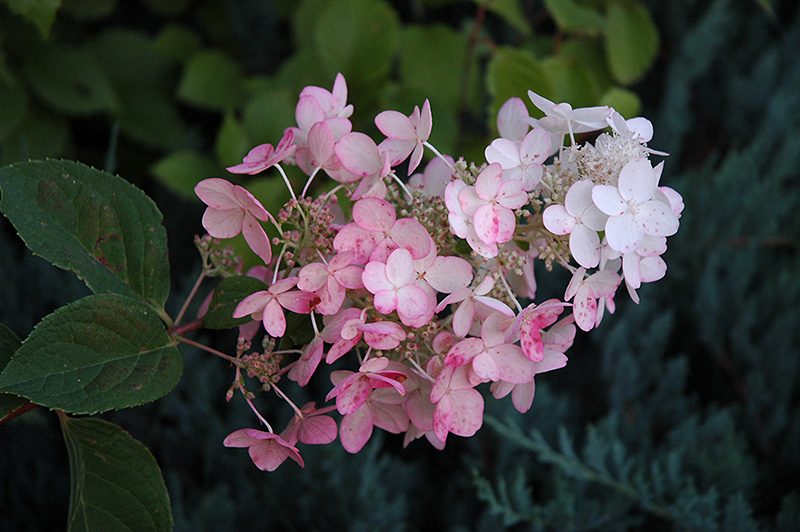
As mentioned above, seeds can be bought, it is desirable that the producer was from China or Japan. But there is also a more laborious process - their independent collection. For sowing, hydrangea seeds are collected in the autumn from fertile flowers. They look very inconspicuous, and always smaller than the rest. There will be no seeds in the lush and beautiful flowers.
Cuttings
For cuttings, it is necessary to take annual shoots. Cut them off by the end of June. In this case, rooting will occur without problems.

Rooted cuttings in a mixture of soils, consisting of peat and sand. In winter, they grow in a cool dark room. But to land in the open ground, they can be next year, closer to mid-summer.
Layering

The lower branches are cut, and in the place of the cut they are dug into the ground, comfortably fixing the plant in the ground. As a rule, by the autumn they give the first roots. But disconnecting them from the common bush is not worth it yet. Only by the next season can they be separated and planted.
Application in garden design
Hydrangea is very popular all over the world. Creamy white, pink, dark pink and red are all Pink Hydrangea hydrangeas during their flowering period. In the warm period, it will decorate a variety of gardens, parks and alleys, delighting with its diversity and uniqueness.
Pink Diamond will look great in combination with coniferous undersized plants. In this case, you can play in contrasts.
It is categorically contraindicated in landscaping to plant yellow, red and orange plants next to hydrangeas.
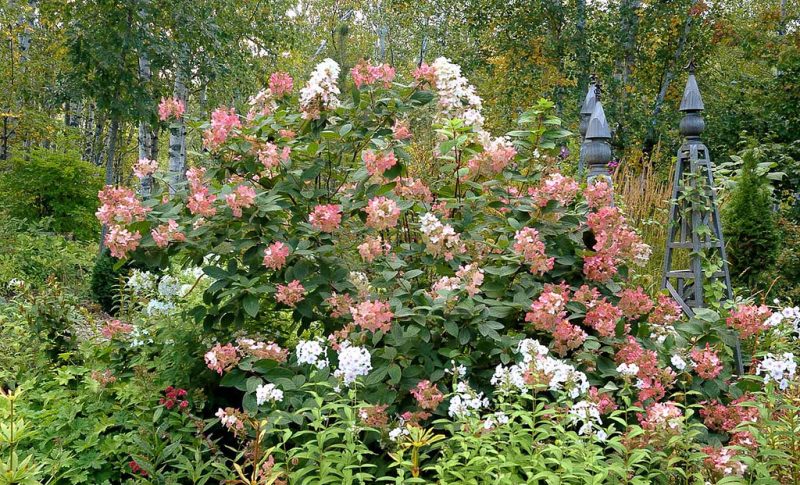
Perfectly complement the garden with hydrangeas clematis, cereals, verbena, hosts.


